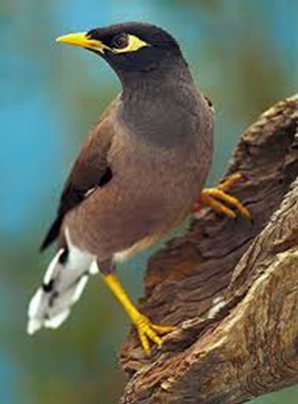WHAT IS A COMMON MYNA?
The Common Myna was introduced into Melbourne’s markets between 1863 and 1872 to control insects. It is now regarded as major pest - the flying cane toad. The Myna bird has been declared the second greatest threat to native birds after land clearing.
Once the birds are established, dramatic increases in density occur. One web site (below) gives numbers: “From one breeding pair, within five years they have the potential for reaching nearly 13,000 birds.”
As scavengers, they are a pest to fruit trees, especially fig, and raid soft fruit and berries. They are also responsible for picking off seedlings in market gardens. But their biggest threat is to Australian wildlife.
The Richmond Valley Council website (below) explains how the Myna goes about its business:
“During the breeding season the flock combs its territory for breeding hollows. If any are already occupied by possums, sugar gliders, rainbow lorikeets, corellas or any other animal species they attack them and eject them from the hollows. If there are eggs or young in the nests they throw them to the ground, the eggs are destroyed, the young killed. Should the parents attempt to defend their home and young, the Indian Mynas keep attacking in large numbers until the defenders are dead or have fled. Any Australian native bird or marsupial that requires tree hollows to live or breed is subject to Indian Myna attack during the nesting season. Any bird or animal that enters the Indian Mynas territory at other times will also be attacked. Indian Mynas do not share territory or food sources willingly. Uncounted millions of Australian native chicks and marsupial babies die from Indian Myna attacks every year. With the adult birds homeless they are unable to breed. Because marsupials are territorial, even if they flee the attack they are unlikely to survive away from their home territory.”
When I lived in Melbourne, I observed these birds standing on the kerb, waiting for the traffic lights to turn red. They then jumped on the road in front of the stationary traffic and picked up anything dead on the tarmac. They jumped back on the kerb just as soon as the lights went green. Pretty smart.
WHY SHOULD WE WORRY?
The Common Myna (also known as the Indian Myna) is on North Arm Cove’s doorstep now. They’re already well established and in significant numbers in Karuah and Tea Gardens.
HOW DO WE RECOGNIZE THEM?
The Common Myna, about 25cm, has a yellow bill, yellow legs and feet, and bare yellow skin behind the eye. Its head and throat are black, the body is cocoa with white underparts. The voice is varied and noisy and it has an arrogant walk.
The birds associate with human habitation, are opportunistic, and devastate wildlife. They compete with, and usually beat, native birds for food and nesting holes. They are found in pairs or flocks and have communal roosts.
[Don’t confuse them with the Noisy Miner, a native resident, which is smaller and has a yellow beak and eye patch, pale grey breast with a white belly and flesh-colored legs. Compare them at http://www.abc.net.au/news/2016-09-08/indian-myna-vs-noisy-bird/7826272.]
WHAT CAN WE DO TO DISCOURAGE THEM?
Don’t offer them food
Cover or move pet food, a favorite food source
Don’t leave food lying around for native birds and animals
Compost or dispose of food scraps with care
Limit nesting opportunities
Identify and patch holes in houses and sheds
Encourage native birds by planting native species. Mynas favour exotic vegetation for food, nesting and protection.
Once the birds are here, we will have a much greater problem trapping and destroying them. Better to stop their arrival!!
For more information: https://www.feralscan.org.au/mynascan/ .
Pat Brennan
References
http://www.abc.net.au/news/rural/2016-09-08/indian-myna-birds-pest-spec…
https://mynabirdtraps.com.au/indian-myna-bird-facts/
http://www.richmondvalley.nsw.gov.au/page/Environment/Indian_Myna_Birds/



